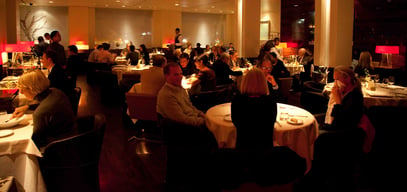This was a real call we received. And it is not an uncommon issue in temperate zones, mostly in the spring or fall, in many parts of the United States. The cause of over-pressurization, or your doors unable to close, is an energy savings measure your HVAC system is trying to utilize.
If you own or operate a restaurant, you are probably familiar with the effects of negative pressure on your building. You may have even had to take steps to adjust the pressure in your store, such as having a test and balance performed. However, are you aware of the causes, and subsequent effects, of over-pressurization?
As the name suggests, over-pressurization occurs when the HVAC system is bringing in significantly more outside air (OA), than air that is being exhausted from the building. This causes positive air pressure to build inside the store.
Let's take a step back, and review how a restaurant's HVAC is designed to function.
- Set Up: On our fictional restaurant roof, we have a roof top unit (RTU) serving the dining room, an RTU serving the kitchen, two exhaust fans, and a makeup air unit that serves the kitchen hood.
- Air Flow: The RTUs that serve the dining room and kitchen are bringing in about 10-15% OA, which is mixed with the return air (RA). The combined air is cooled or heated and blown into the space. That is the supply air (SA), which is what the guests and kitchen staff feel during the heating/cooling cycle. This is described by the formula OA+RA=SA. We'll need that later.
- Air Pressure: One of the exhaust fans is small and exhausts the restrooms. The restroom is left with a slight negative pressure to keep restroom air from reaching the dining space. The other exhaust fan is larger and provides exhaust for the kitchen hood. To avoid a large pressure difference from the dining area to the kitchen due to the hood, there is a make-up air unit that provides OA to balance the kitchen.
When all these components are balanced and running as designed, the building is left with a slight positive pressure relative to outside.

As the years have gone on, and technology has improved, RTU's have been designed to reduce energy consumption, when possible. Free-cooling is a mode that current RTU's are equipped with to utilize desirable external ambient temperature to supply the space. This mode brings in more OA and less RA than usual to reduce the amount the air needs to be heated or cooled. This significantly saves energy. However, if your store is not designed for the energy saving mode, you can run into issues.
What exactly is the RTU doing during free-cooling that is supposed to save energy, but is causing trouble?
On the unit, there is an OA hood, an OA damper, and a RA damper. During free cooling, the unit senses the temperature outside is around the setpoint, typically 70 degrees. It will close the RA damper and open the OA damper all the way. Here is where the formula comes in.
Normally OA + RA = SA. For this example, let's say OA = 50 cfm, RA= 100 cfm, and SA therefore = 150 cfm.
During free-cooling, when the OA damper is opened all the way, the cfm that is brought in is typically higher than normal OA + RA cfm. Let's see it in the formula.
Free cooling: OA = 300, RA = 0, therefore SA = 300
300 + 0 = 300
What's the issue?
There is only enough exhaust coming from the building to balance 150 cfm.
That leftover 150 cfm will push on the walls, windows, and doors to find its way out. If the pressure is high enough, it can prevent doors from closing, and depending on the duration, cause an increase on your energy bill.
There are solutions to this issue that depend on the type of units you have installed, but we are here to help.

